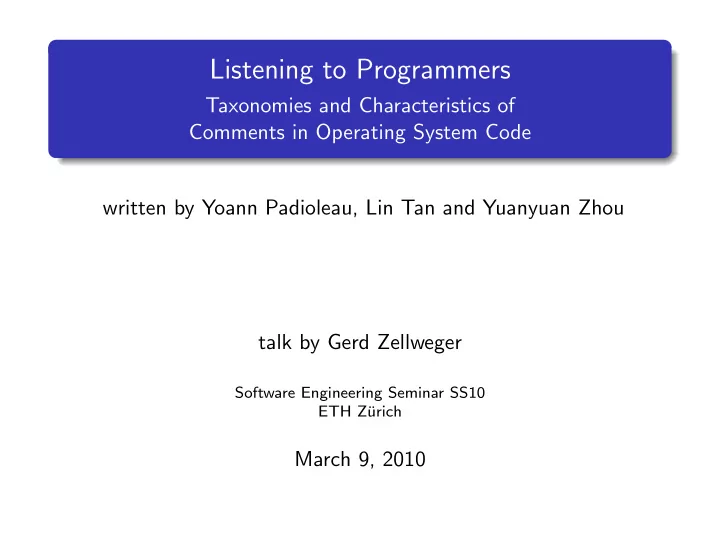

Listening to Programmers Taxonomies and Characteristics of Comments in Operating System Code written by Yoann Padioleau, Lin Tan and Yuanyuan Zhou talk by Gerd Zellweger Software Engineering Seminar SS10 ETH Z¨ urich March 9, 2010
Motivation How can we improve Software reliability? Programming Language Extensions New Development Tools Annotation Languages 2 / 16
Motivation How can we improve Software reliability? Programming Language Extensions New Development Tools Annotation Languages Better Programming Languages 2 / 16
What do programmers need? Unfortunately many of these innovations are not fully leveraged by programmers. 3 / 16
Studying comments can help... ... improving programming languages. struct st_drivetype { char* name; int len; }; const struct st_drivetypes[] = { "Unisys...", // name 15, // length }; 4 / 16
Studying comments can help... ... improving programming languages. struct st_drivetype { char* name; int len; }; const struct st_drivetypes[] = { "Unisys...", // name 15, // length }; This led to the GCC Designator Extensions. struct st_drivetypes st = { .name = "Unisys...", .len = 15 }; 4 / 16
Methodology LOC 5.2M LOC 2.4M LOC 3.7M Comments: Comments: Comments: 1.2M (23.1%) 0.6M (25%) 1.1M (29.7%) 5 / 16
Methodology LOC 5.2M LOC 2.4M LOC 3.7M Comments: Comments: Comments: 1.2M (23.1%) 0.6M (25%) 1.1M (29.7%) 350 Comments per OS selected at random 5 / 16
Methodology LOC 5.2M LOC 2.4M LOC 3.7M Comments: Comments: Comments: 1.2M (23.1%) 0.6M (25%) 1.1M (29.7%) 350 Comments per OS selected at random Challenge 1: Understand the content of the comment 5 / 16
Methodology LOC 5.2M LOC 2.4M LOC 3.7M Comments: Comments: Comments: 1.2M (23.1%) 0.6M (25%) 1.1M (29.7%) 350 Comments per OS selected at random Challenge 1: Understand the content of the comment Challenge 2: No taxonomy based on comment content (yet) 5 / 16
Methodology LOC 5.2M LOC 2.4M LOC 3.7M Comments: Comments: Comments: 1.2M (23.1%) 0.6M (25%) 1.1M (29.7%) 350 Comments per OS selected at random Challenge 1: Understand the content of the comment Challenge 2: No taxonomy based on comment content (yet) Issue 1: No general conclusions about comments in software 5 / 16
Methodology LOC 5.2M LOC 2.4M LOC 3.7M Comments: Comments: Comments: 1.2M (23.1%) 0.6M (25%) 1.1M (29.7%) 350 Comments per OS selected at random Challenge 1: Understand the content of the comment Challenge 2: No taxonomy based on comment content (yet) Issue 1: No general conclusions about comments in software Issue 2: Subjectivity 5 / 16
Methodology LOC 5.2M LOC 2.4M LOC 3.7M Comments: Comments: Comments: 1.2M (23.1%) 0.6M (25%) 1.1M (29.7%) 350 Comments per OS selected at random Challenge 1: Understand the content of the comment Challenge 2: No taxonomy based on comment content (yet) Issue 1: No general conclusions about comments in software Issue 2: Subjectivity Issue 3: Fixed amount of comments 5 / 16
Taxonomies of Comments 6 / 16
Taxonomies of Comments 7 / 16
Demo 8 / 16
Exploitable Comments Exploitable Toplevel Content Categories Type Interface Code Relationship PastFuture 9 / 16
Exploitable Comments Exploitable Toplevel Content Categories Type Interface Code Relationship PastFuture Exploitable Comment Can potentially be used by existing work or inspire new work. 9 / 16
Exploitable Comments Exploitable Toplevel Content Categories Type Interface Code Relationship PastFuture Exploitable Comment Can potentially be used by existing work or inspire new work. 52 . 6 ± 2 . 9 % Comments in the three OSs belong to these four top level content Categories. 9 / 16
Exploitable Comments: Integers and Integer Macros F1: 22 . 1% of the exploitable comments describe the usage and meaning of integers and integer macros. 10 / 16
Exploitable Comments: Integers and Integer Macros F1: 22 . 1% of the exploitable comments describe the usage and meaning of integers and integer macros. Bits and Bytes # define IXGB_GPTCL 0x02108 /* Good Packets Transmitted Count */ 10 / 16
Exploitable Comments: Integers and Integer Macros F1: 22 . 1% of the exploitable comments describe the usage and meaning of integers and integer macros. Bits and Bytes # define IXGB_GPTCL 0x02108 /* Good Packets Transmitted Count */ Error Returns /* return 1 if ACK, 0 if NAK, -1 if error */ static int slhci_transaction(...) { ... } 10 / 16
Exploitable Comments: Particular Code Relationship F2: 16 . 8% of the exploitable comments specify or emphasize some particular code relationship. 11 / 16
Exploitable Comments: Particular Code Relationship F2: 16 . 8% of the exploitable comments specify or emphasize some particular code relationship. Data Flow bool vdev_nowritecache; /* true if flushwritecache failed */ 11 / 16
Exploitable Comments: Particular Code Relationship F2: 16 . 8% of the exploitable comments specify or emphasize some particular code relationship. Data Flow bool vdev_nowritecache; /* true if flushwritecache failed */ Control Flow switch (i) { case 0: printf("0"); break; case 1: printf("1"); break; default: /* Not reached */ } 11 / 16
Annotation Languages F5: At least 10 . 7% of the exploitable comments can be expressed via annotation languages. 12 / 16
Summary Comments are written when programmers have no other way to express their intentions Analyzed 1050 comments from three Operating Systems 52 . 6% Comments are exploitable comments 10 . 7% of the exploitable comments can be expressed via annotation languages 13 / 16
Links & Literature Paper http://ieeexplore.ieee.org/xpl/freeabs all.jsp?arnumber=5070533 CComment: http://opera.ucsd.edu/CComment/ Deputy: http://deputy.cs.berkeley.edu/ Splint: http://www.splint.org/ Sparse: http://sparse.wiki.kernel.org Article on Lock Lint: http://developers.sun.com/solaris/articles/locklint.html 14 / 16
Comment Age & Location 15 / 16
Non OS Study Study based on... Eclipse (Java) MySQL (C, C++) Firefox (C, C++) 16 / 16
Recommend
More recommend